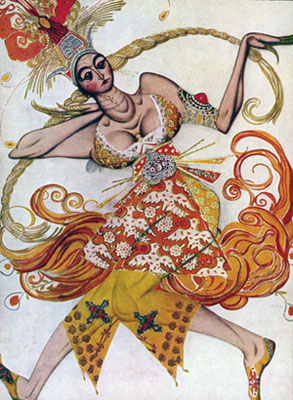![]()
What you must do in this unit
- Read the textbook chapter 31 (mainly pages 410-15).
- Check the remarks by Professor Blois and Professor Evans on Russia's Silver Age.
- Study the Questions to Consider and the Key Terms for the Unit.
- Post (or respond) with your thoughts/ideas/comments about this unit's reading in the Canvas discussion forum (5 points).
What you can do in this unit
- These chapters from Russia of the Russians offer a contemporary assessment of Russian cultural accomplishments in these different areas during the Silver age.
Some videos that you can watch for this unit
- An Introduction to Anton Chekhov
- Maxim Gorky FilmImages.mp4
- Stravinsky - Ballets Russes - Sacre du printemps – Firebird
- The Golden Age of Art - Celebrating 100 Years of the Ballets Russes
- Arts.21 | Dance Revolution The Ballets Russes Turns 100
- Tamara Karsavina On Dancing in 'Giselle' with Vaslav Nijinsky in Paris in 1910
- Ballets Russes archive footage found
- For extra credit please suggest to your instructor a relevant video for this unit of the course. Send the title of the video, the URL and a brief explanation of why you find the video interesting and applicable to the material that is being studied in this unit.
Extra Credit Options
- For up to 25 points of extra credit, watch Dama s Sobachkoi (The Lady with the Little Dog) and write a one-page paper about the "little dog."
- For up to 25 points of extra credit (maybe more), visit Hillwood Estate, Museum & Gardens and comment on the Fabergé eggs and the Russian art collection there as representative of the Russian Silver Age.
- For up to 25 points of extra credit, watch Neokonchenaya Piesa dlia Mekhanicheskogo Pianino (Unfinished Piece for the Player Piano) and write a one-page paper of what was so fascinating in the movie.
- For up to 25 points of extra credit, listen to Igor Stravinskii's The Rite of Spring--You can watch the version in Fantasia (1940) and write a one-page paper in which you explain the historical impact of this piece.
- For up to 25 points of extra credit, watch a production of one of the performances/choreographies of Diaghilev's Ballets Russes and write a one-page paper in which you explain to me what you found so exciting.
- For up to 25 points of extra credit, read John Bowlt, The Silver Age (1982) and write a one-page paper describing the author's identification of the main features of the Silver Age.
- For up to 25 points of extra credit, read Aleksandr Blok (1880-1921), Verses on a Beautiful Lady (1904) and write a one-page paper describing some of the main themes of the poems in the context of Russian symbolism.
- For up to 25 points of extra credit, read Maksim Gorkii (1868-1936), Mother (1906) and write a one-page paper in which you answer the question, "How did Gorkii portray elements of Russian society previously not found suitable for the Russian reading public?"
- For up to 25 points of extra credit, read Mikhail Artsybashev, Sanin (1908) and write a one-page paper explaining what Russian society found so offensive about the novel.
- For up to 25 points of extra credit, read Anton Chekhov (1860-1904), Uncle Vanya (1899) or The Cherry Orchard (1904) and write a one-page paper comparing Chekhov's work to that of Henrik Ibsen (1828-1906).
- For up to 10 points of extra credit, after looking through some of the recommended websites for the unit, write a long paragraph that identifies some of the unifying features of the Russian silver age.
Unit Learning Objectives
- Upon successful completion of this unit, you will be able to (1) demonstrate knowledge of some of the key individuals (and their artistic works) that were part of the Russian Silver Age.
